THE COMMONS
For alumni and friends of the Nelson Institute for Environmental Studies at the University of Wisconsin–Madison


For alumni and friends of the Nelson Institute for Environmental Studies at the University of Wisconsin–Madison

The first global-scale test of why birds sing the way they do.
New research about renewable energy in Wisconsin. Page 2
Taking sustainability research and action to the community. Page 16
PhD student Dorothy Lsoto awarded Next Generation Fellowship. Page 20
EDITORIAL STAFF
Kevin Berger, Graphic Designer
Anica Graney, Assistant Editor
Eric Klister, Web Editor
Chelsea Rademacher, Editor
Laila Smith, Staff Writer
Diane Stojanovich, Managing Editor
CONTRIBUTORS
Abigail Becker
Brynne Hill
Esther Seidlitz Catie Stumpf
DEAN’S OFFICE
Paul Robbins, Dean, Nelson Institute for Environmental Studies
Anna Gade, Associate Dean for Research and Education
Diane Stojanovich, Distinguished Associate Dean for Communications
Shelly Strom, Assistant to Paul Robbins
Steph Tai, Associate Dean for Education and Faculty Affairs
Jenna Weidner, Associate Dean for Administration
CONTACT US
We’d love to hear from you! Send us feedback or questions about this issue, or share story ideas for future issues.
Nelson Institute for Environmental Studies 550 Science Hall Madison, WI 53706 communications@nelson.wisc.edu
Stay connected by updating your contact information or by joining our LinkedIn group
We’re reducing our carbon footprint! We hope you enjoy our digitally published magazine, sent monthly to Nelson alumni, students, and friends.
Energizing Wisconsin What will it take to meet Wisconsin’s renewable energy goal … and what will it cost? 4 Supporting Proactive Sustainability Through UniverCity Alliance, the Village of DeForest is addressing natural asset protection and community sustainability efforts in partnership with UW–Madison students.
8 The Soundtrack of Conservation Why do birds make so many different sounds? A new UW–Madison study gets at the underlying factors.
Forecast: Extreme How Wisconsin’s rural communities are prepping for more extreme weather events.
Greetings, Nelson Institute community,
Even if your March is coming in like a lion, I hope you are all easing gently into the rhythm of spring. We have harbingers aplenty here in Madison: from the extended sunlight to the first signs of daffodil bulbs to a flurry of activity as students prepare for spring break. Forgive the grandiloquence, but these signs are a welcome reminder that, come what may, life finds a way. But sometimes — whether fictional dinosaurs or very real North American mammals — that life needs some help. And it’s in that spirit that I’d like to use this month’s letter to restate our values and commitments.
It is, I imagine, of no surprise to this community that changes at the federal level are being felt here at the Nelson Institute. Personnel cuts, stop-work orders, and funding freezes at agencies including the U.S. Agency for International Development (USAID), the National Oceanic and Atmospheric Administration (NOAA), the National Science Foundation (NSF), the National Institutes of Health (NIH), and more are having immediate and direct affects to not only the livelihoods of our faculty, staff, and students, but also to their ground-breaking, life-changing, and environmentally beneficial work. To quote our chancellor, “These actions could not only result in contract cancellations that could impact UW–Madison’s ability to propose new research and carry out existing projects but also pose significant risk to our nation’s historic strength in scientific research.”

makes their people healthier. Because of Nelson Institute scholarship and educational programs, students can find their way to transformational sustainability work, coming from a huge range of backgrounds to our Community Environmental Scholars Program. Because of Nelson research, emergency management directors in rural Wisconsin can better prepare their counties for extreme weather events. Because of research support from the Office of Sustainability, here in the Nelson Institute, farmers can keep working their land while also creating solar power. This work is real, tangible, and it matters. We remain dedicated to it.
Though the manner in which this work will continue to be carried out will adapt to ever-changing conditions and challenges, we at the Nelson Institute, and UW–Madison at large, remain fully committed to our mission:
“To provide a learning environment in which faculty, staff, and students can discover, examine critically, preserve and transmit the knowledge, wisdom and values that will help ensure the survival of this and future generations and improve the quality of life for all.”
For more and up-to-date information, please visit UW–Madison’s federal relations website
Forward,
Can you be more specific, I hear you ask? Certainly. Because of Nelson research, American cities can follow a framework that saves them money, mitigates climate changes, and

Paul Robbins Dean, Nelson Institute


The state of Wisconsin is on a mission to be entirely powered by carbon-free electricity by 2050. Pros and cons aside, complex questions remain: what are the long-term costs? What if the best spot for a solar array is smack-dab in the middle of a family farm? UW–Madison researchers explore these questions and more — including how agrivoltaics (pictured here) can offer a unique solution — in a special two-part edition of the Nelson Issue Brief. Photo by Lauren Graves, Office of Sustainability
Through UniverCity Alliance, the Village of DeForest is addressing natural asset protection and community sustainability efforts in partnership with UW–Madison students.
By Abigail Becker, UniverCity Alliance
As the Village of DeForest — home to the Yahara River headwaters — has steadily grown in population and household size over the last two decades, local elected officials want to be prepared for change and protect the village’s natural resource gems.
“We’ve really tried to emphasize being stewards of our land and water,” said Judd Blau, director of public services and deputy administrator for DeForest. “How do we allow development to happen while balancing the needs of nature?”
These are the types of big questions that DeForest hopes to move closer to answering through its partnership with UniverCity Alliance. Through its multiyear program that connects Wisconsin local governments with university resources, DeForest is addressing focus areas in its strategic plan, including growth and natural resource use.
“It’s a community wanting to be proactive, rather than just reactive … which really speaks to their long term commitment.”
— Heidi Putnam
“Part of the strategy here is to try to get ahead of those changes instead of reacting or putting out fires,” village administrator Bill Chang said. “Understanding that we can’t hire all that help out and understanding that there is also a need for being efficient, effective, and resilient, is why we started to look at UniverCity.”
To address environmental sustainability, DeForest collaborated with Heidi Putnam, who graduated in Au -
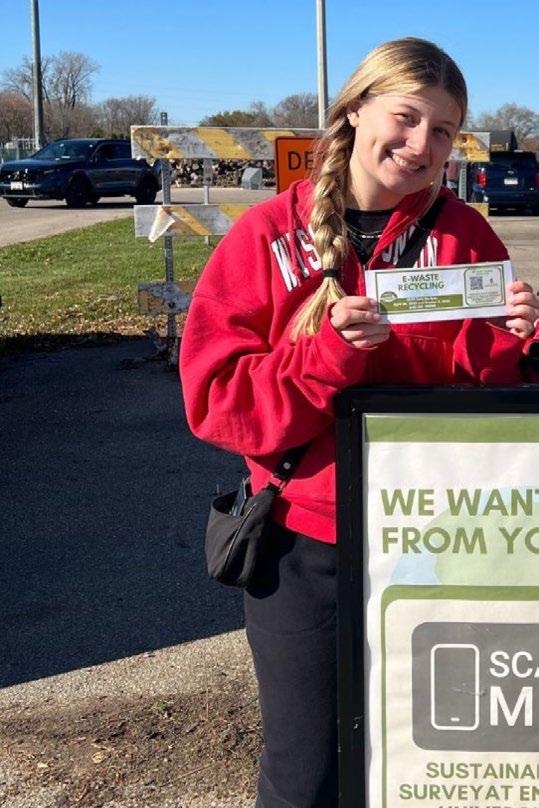
gust 2024 with a master’s degree in urban and regional planning, to develop a framework to determine varied levels of protection of natural areas that still allows for a variety of development.
DeForest also worked with two undergraduate students, Carolyn Shumaker and Julia Fechner, who were a part of the UniverCity Alliance Scholars Program, to explore, assess, and document sustainability practices happening in the village.
While this partnership is creating relationships between community partners and the university, it also connected Putnam, Shumaker, and Fechner. Shumaker and Fechner both work at the UW–Madison Office of Sustainability. Additionally, Putnam was a teaching assistant for a class that Shumaker took and met with the students during the course of their project to share notes, connections with helpful DeForest community members, and insight into how local government works.

“It helped me from reinventing the wheel,” said Shumaker, a senior majoring in landscape and urban studies, geography, and environmental studies. “It feels like we’re carrying the same torch, but in a different way.
Julia Fechner (left) and Carolyn Shumaker attended an e-waste recycling event in DeForest to encourage residents to complete their survey. Photos courtesy of the Village of DeForest (2)
We’re not running the exact same race, but we’re still moving forward.”
When it comes to addressing complicated challenges like balancing development and natural resource protection, collaboration has to be part of the answer. UniverCity provides a unique resource to Wisconsin local leaders looking to leverage resources at the university to address thorny issues.
“Working with UW–Madison instructors and students can provide a unique perspective to the challenges happening in Wisconsin communities,” UniverCity Alliance managing director Gavin Luter said. “At the same time, these instructors and students can learn from on-the-ground experts and incorporate local expertise into their projects.”
For Putnam, working with the Village of DeForest on watershed planning aligned with her research and professional interests. But it also was a continuation of her commitment as a student to community-engaged work.
Putnam had previous experience with UniverCity, including working with local farmers and community members to develop a plan for the Koshkonong Creek watershed and creating a branding plan for Polk County. She said these project-based opportunities
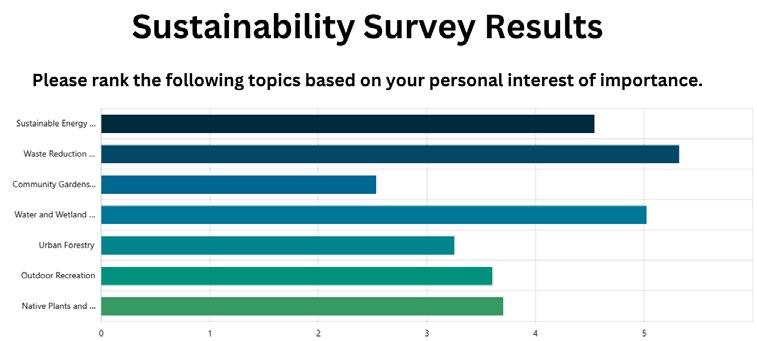
were why she chose to attend UW–Madison.
“From a planning perspective, it’s a great way to learn how to communicate better with communities and elected officials and staff members, and so I could get some of those soft skills that you don’t learn in the classroom that I can use as a professional,” Putnam said. “I wanted to do something that made a difference rather than just a plan that sits on a shelf.”

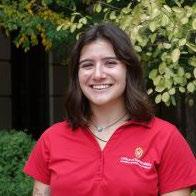
With her project, the goals were to protect surface water quality by reducing the phosphorus load entering the Yahara River from untreated stormwater runoff and to reduce the impacts of stormwater flooding on infrastructure and the natural environment.
Putnam’s project ultimately recommended zones to prioritize for natural asset protection. Moving forward, DeForest staff could use these recommendations in future planning discussions and to start a community dialogue around green infrastructure planning and natural asset protection.
Putnam said she was excited to specifically work with DeForest because of the village’s approach to safeguarding natural resources, referencing the effort to preserve a buffer of 300 acres of land along nearly all the Yahara River within the village’s boundaries.
“It’s a community wanting to be proactive, rather than just reactive to what’s going on in their community, especially the waterway,” Putnam said. “They already have taken great initiatives to plan this giant green environmental corridor going along most of the riverway
through the community, which really speaks to their long term commitment.”
Blau said Putnam set a “high bar” with her project. Additionally, he said the UniverCity partnership has been everything he hoped for and that putting in the time to guide students who return a strong deliverable has been worthwhile.
“I really saw it as a win-win opportunity for ourselves in the village to tap into young, fresh ideas that are coming out of university and to do it at an inexpensive cost,” Blau said.
In another sustainability project for DeForest, Shumaker and Fechner developed a report outlining interventions on energy use, waste reduction, and flood and climate resilience. They wrote a survey to find out what aspects of sustainability
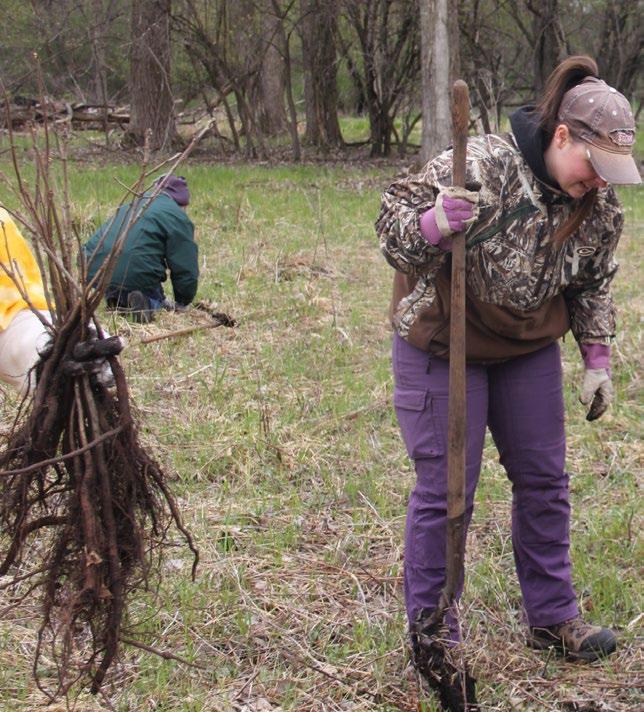
DeForest residents care most about, created an interactive sustainability map that highlights examples of environmental stewardship and sustainability within DeForest, and designed a pamphlet focused on community education.
Through UniverCity’s model, community partners receive tangible deliverables, and students receive valuable experiences working directly with experts in the field. As a senior, Shumaker said this experience made her feel “more capable” as she navigates the post-graduate world and applies for jobs.
Fechner said her academic work through the landscape and urban

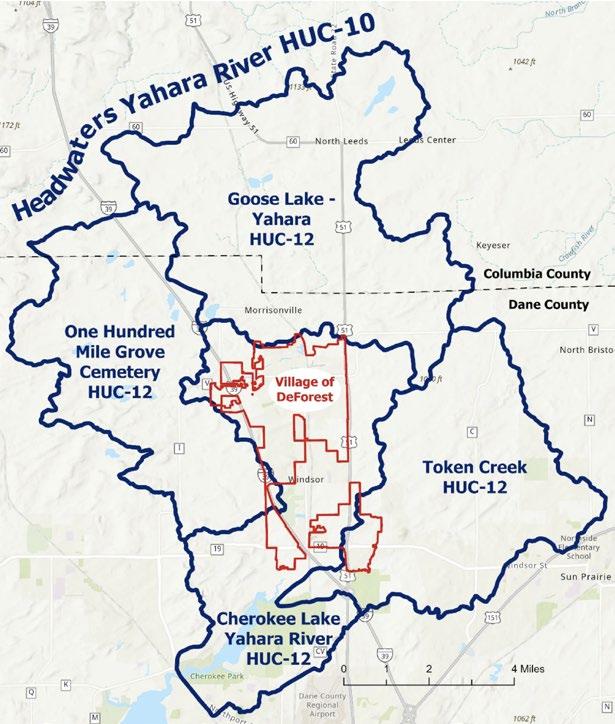
studies major was applicable to the project with DeForest and vice versa.
However, she said the most important aspect of the project was engaging with the community. Fechner and Shumaker attended an e-waste recycling event in DeForest to recruit residents to take their survey, so their project could focus on what’s most important to residents regarding sustainability.
“We wanted to prioritize what the community actually wants,” Fechner said. “That’s been one of the biggest things that I’ve valued within this project is being able to have those connections.”

By Elise Mahon, UW–Madison Office of Strategic Communication
Birds make sounds to communicate, whether to find a potential mate, ward off predators, or just sing for pleasure.
But the conditions that contribute to the immense diversity of the sounds they make are not well understood. Researchers at the University of Wisconsin–Madison have conducted the first-ever global study of the factors that influence bird sounds, using more than 100,000 audio recordings from around the world. The new study, recently published in the journal Proceedings of the Royal Society B, revealed insightful patterns for why birds make certain noises and at what frequency.
“There’s very little that we know about the forces that govern soundscapes.”
— H.S. Sathya Chandra Sagar
Hypotheses about the role of habitat, geography, body size and beak shape in forming bird sounds have been tested on small scales before. But H.S. Sathya Chandra Sagar, a UW–Madison doctoral student who works with Professor
Zuzana Buřivalová in the Department of Forest and Wildlife Ecology and the Nelson Institute for Environmental Studies, wanted to see if they held up on a global scale.
Sagar analyzed audio recordings of bird sounds taken by people around the world and submitted to a bird-watching repository called xeno-canto. The analyzed recordings represented 77 percent of known bird species.
The study’s major takeaways included:
• Bird species’ habitat influences the frequency of the sound they may make, in unexpected ways. For example, in ecosystems with a lot of rushing water there is a constant level of white noise occurring at a lower frequency. In such cases, researchers found that birds tend to make sounds of higher frequency, likely so they wouldn’t be drowned out by the water.
• Bird species living at the same latitudes make similar sounds. Observing this pattern at a global scale is an important piece of the puzzle in the evolutionary story of bird sounds. It could inspire further research into the aspects of geographic location that influence bird sounds.
• A bird’s beak shape and body mass are important. Generally, smaller birds create higher frequency sounds while larger birds create lower frequency sounds. The global analysis not only proved this hypothesis correct, but it also added new information about the nature of the relationship between beak shape, body mass and sound.
• Smaller bird species tend to have a wider range of frequencies at which they can make sound as a protection mechanism. Smaller, more vulnerable birds can benefit from being able to make a range of sounds. Higher frequencies can help them communicate with fellow birds of the same species, while lower frequencies can serve as a camouflage, tricking potential threats into thinking they are larger and less vulnerable than they actually are.
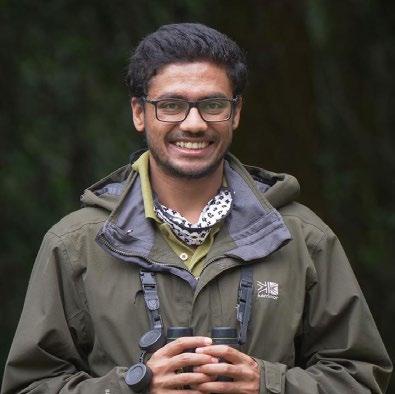


The research also contributed to the broader understanding of soundscapes — all of the sounds heard in any particular landscape. Soundscapes are often used as part of conservation studies, but Sagar realized “there’s very little that we know about the forces that govern soundscapes.”
He hopes this foundational work will provide a platform for future studies to improve conservation efforts by developing ways to monitor the health of an ecosystem through soundscapes.
“In the tropics and all over the world, larger birds tend to be hunted for meat,” he says as an example. “Larger birds [tend] to call at a low frequency, and if we don’t find any sound in the lower frequency, we could [conclude] there may be more hunting in this landscape.”
Next, Sagar hopes to use 24-hour soundscape recordings to understand if some birds modify the timing of their song in addition to their frequencies to communicate with their peers in a landscape crowded with noise. And he notes the important role that birdwatchers and citizen scientists play in discovering new insights about our natural world.
This story was originally published by news.wisc.edu.
By Deilee Calvert, UW-Madison Division of Extension

Sherri Congleton, Vilas County emergency management director, has seen the impact of changes in weather extremes over time. “Even as a kid, I remember we had winter. It was cold, you had snow, you did those things.”
But that’s not always the case these days. “Last winter we didn’t have enough snow to even open the [snowmobiling] trails. There’s no typical anymore,” said Congleton. And that makes planning for weather events more complicated. In 2020, Vilas County experienced two tornadoes on the same day. “We have a lot of wind events. But we hadn’t had a tornado since 1995. It was bizarre.”
Wisconsin is projected to experience more frequent and intense extreme weather events. These events impact infrastructure, public health, agricultural systems, and more, resulting in significant economic losses and social disruption. The Extreme Weather Index, developed by the Wisconsin State Climatology Office, shows that Wisconsin has experienced its most extreme weather in the past decade since record-keeping began in 1895.
Steve Vavrus, director of the State Climatology Office, has been tracking weather for a long time. “The 2010s were Wisconsin’s wettest decade on record and the second-warmest. The state was struck by more than 20 ‘once-in-a-century’ rainfalls, including the infamous August 2018 flood in Dane County that dumped around a foot of rain in a single day,” said Vavrus.
Vavrus, along with Ken Genskow, professor and extension specialist in the Department of Planning and Landscape Architecture, and Paul Block, associate professor in the Department of Civil and Environmental Engineering, all affiliated with the Nelson Institute for Environmental Studies, are coleading a UW–Madison project for the Wisconsin Rural Partnerships Institute (RPI) to increase climate-resiliency in rural areas of the state. RPI is part of a broader $28 million USDA-funded Institute for Rural Partnerships, housed at the UW–Madison College of Agricultural and Life Sciences, Auburn University, and the University of Vermont.
Developing Data, Tools, and Resources
Congleton is one of many emergency management directors, public health officials, and hazard planners working with UW–Madison researchers and Extension specialists to prepare for amplified weather extremes. The project, funded through RPI, is focused on building greater capacity in Wisconsin’s rural communities. Collaborating with farmers, local hazard planning/emergency management officials, and rural schools, they hope to provide data, tools, and resources that will improve the ability to make informed decisions in advance of extreme weather events.
Consistent with the goals of the RPI, Genskow reinforced that working with those groups helps extend the reach of the project to rural residents affected by extreme events. Hazard planners, public health officials, and school districts are important lines of communication before and during extreme weather events. “We hope this project provides planning and decision-support tools to help ensure they are ready with information when needed and can take longer-term actions in advance that may reduce some of the potential impacts.”
Currently, the project is focused on rural communities in three regions of the state — the Driftless Area, the Central Sands, and Northern Wisconsin. Within those regions, the project is identifying communities and local stakeholders who are interested in leveraging resources and expertise from UW-Madison and Extension to better prepare for extreme weather.
“Utilizing the resources at UW–Madison and Extension, we will work with communities to codesign tools they think would be helpful.”
— Ken Genskow
The First Step Through engagement activities and focused discussion, the group is collecting information from communities about what they are doing, what is going well and what challenges exist. Those discussions will allow the team to identify how extreme weather events are impacting the community and what tools and resources can be developed to improve decision-making processes. Working with partners across UW–Madison, they plan to codevelop forecast and climate change-focused products that are informed by an understanding of the needs, priorities, and expected future conditions of these communities.
Jackson Parr, climate and hazards planning educator with the UW–Madison Division of Extension, said that starting with discussions is paramount to the success of the project.
“We have been very intentional about letting communities tell us what they need and not the other way around,” said Parr. Letting communities lead the project means that the end product will be used to keep communities safe.
“We could collect more data or develop additional analytical tools, but if the resulting resource does not meet the needs of people on the ground or fit into their existing workflows, it won’t have the impact we’re aiming for.”
Already, the team has identified a few common needs.
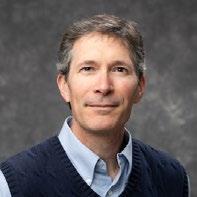
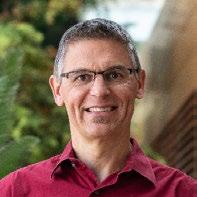
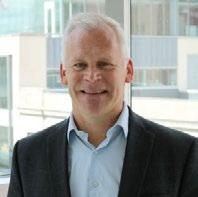
One is that communities are interested in building energy-resilient communities to prevent power outages when extreme weather events occur. Another is a growing concern about getting weather information to rural households, especially those with older or vulnerable residents who might not use cell phones. “Those are just a few of the things we’ve heard, but we are at the beginning stages of meeting with communities,” said Parr.
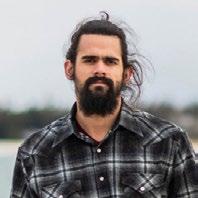
After the team understands the needs, they will begin to develop solutions. “Utilizing the resources at UW–Madison and Extension, we will work with communities to codesign tools they think would be helpful,” said Genskow. Before that, they plan to talk with counties, municipalities, school districts, agricultural organizations, and other community groups that experience extreme weather events including flooding, drought, extreme heat and cold, wildfires, high winds, and false springs.
This story was originally published by the Division of Extension.

Excellence in outreach recognized with Bassam Z. Shakhashiri Public Science Engagement Award.
By Natasha Kassulke, Office of the Vice Chancellor for Research
Michael Notaro, director of the Nelson Institute’s Center for Climatic Research, is one of two recipients of this year’s Bassam Z. Shakhashiri Public Science Engagement Award. He shares the honor alongside plant pathology professor Claudia Solís-Lemus.
The award, in its third year, is named for Bassam Z. Shakhashiri, emeritus professor of chemistry and the William T. Evjue Distinguished Chair for the Wisconsin Idea, in honor of his “Science is Fun” philosophy and long-term commitment to science education and public engagement. The award recognizes one University of Wisconsin–Madison faculty and one academic staff member who have shown excellence in engaging the public in STEAM (Science, Technology, Engineering, Arts and Math) research.
“The selection committee has named Professor Claudia Solís-Lemus (faculty awardee) and Michael Notaro (academic staff awardee) the 2025 recipients of the Bassam Shakhashiri Public Engagement in Science Awards and I join in offering my congratulations,” says Shakhashiri. “Science and society have what is essentially a social contract that enables great intellectual achievements but comes with mutual expectations of benefiting the human condition and protecting our planet.”
“We must engage the public in meaningful conversations in and about science and technology,” Shakhashiri says. “Our research satisfies our curiosity, and we enjoy it. However, we have a responsibility to serve society. We must succeed in enabling people to make informed choices, be skeptical, reject shams, quackery, and unproven conjecture, and to avoid being bamboozled into making foolish decisions where matters of science and technology are concerned.”
This award is cosponsored by the Office of the Vice Chancellor for Research, Wisconsin Alumni Research Foundation, and the Morgridge Institute for Research.
“This year’s awardees are champions for elevating diverse voices in STEM by removing barriers to STEM education and connecting data science, climate science and art. In doing so, they are furthering the Wisconsin Idea and inspiring the next generation of researchers,” says Dorota Brzezinska, vice chancellor for research. “Claudia and Michael are celebrated with this award, especially for helping remove barriers to success in STEM for Latinx, neurodivergent and other marginalized communities.”
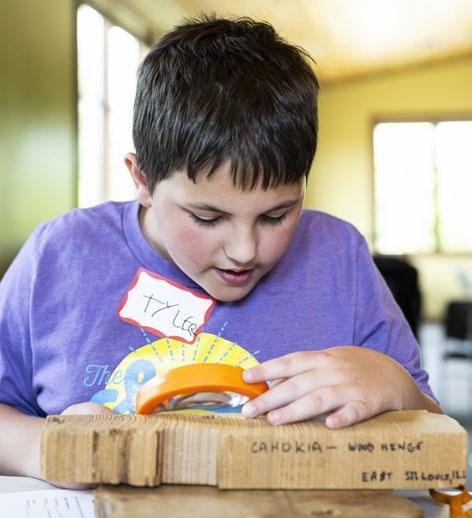
About Michael Notaro
Notaro, who holds a PhD in atmospheric sciences from the University at Albany, is director of the Nelson Institute Center for Climatic Research (CCR) and has worked at CCR for more than 20 years. As a scientist III, he is the first academic staff member to hold the position of CCR director in its six-decade history.
Over those 20-plus years, Notaro has worked on a diverse set of research and outreach topics, including regional climate modeling in the Midwest and Great Lakes Basin in support of dynamically downscaled climate change projections; land-atmosphere interactions including vegetation feedbacks on global monsoons and lake-effect snow; climate change impacts on aquatic and terrestrial ecosystems and wildlife; Middle Eastern dust storms; and K-12 climate education.
He uses this robust academic background as the basis for public STEM outreach to community organizations, children, adults and teachers from a variety of backgrounds, tailoring it to their interests and learning styles.
Notaro is widely respected for his extensive list of science outreach, children’s programs, STEM camps for diverse youth, and citizen-science teacher training workshops that he builds and runs each year.
He is a Wisconsin GLOBE (Global Learning and Observations to Benefit the Environment) partner/trainer, working with K-12 schools to implement NASA’s hands-on, youth citizen science program. Using GLOBE protocols, Notaro runs a variety of camps and programs that teach students and their teachers how to collect natural science data and upload it to a long-running database. Children record information from their communities about temperature, vegetation cover, water clarity, and precipitation, and then compare this against data reported from their location going back decades. In this way, participants learn how scientists collect and analyze information, and can develop and implement locally-relevant research projects in their communities.
One such program is his National Science Foundation-funded WELCOME program, focused on the School District of Beloit, which aims to build STEM skills, remove barriers to STEM fields, and broaden geoscience opportunities for diverse youth. He also leads three GLOBE-inspired STEM camps aimed at fostering neurodiversity in science: The Sky’s the Limit camp in Beloit and Nature’s Navigators in the Wisconsin Dells offer specially tailored opportunities for autistic youth, and Beloit’s Muddy Waters STEMinist Camp empowers high school girls to investigate the many facets of STEM through the lens of water science.

Notaro is a sought-after speaker, including speaking to professional audiences such as the United Nations, about his work. He also teaches AOS 100 Weather and Climate through the Summer Collegiate Experience Program, a six-week program designed for incoming first-year undergraduates from first-generation and other underrepresented backgrounds.
“Science and technology are the engines that drive our economy and greatly contribute to the quality of life and to the well-being of society,” Shakhashiri says, “I call on everyone at UW–Madison to purposefully connect and share the value of our scholarly research and education work with the general public. We must connect locally and with communities in every corner of the state, and across the nation.”
A monthly update from faculty, staff, and students in the Office of SustainabilityEducation and Research.
A biologist, a librarian, and a finance administrator log onto a Zoom call. It’s not the start of a joke — it’s the start of a conversation about sustainability at UW–Madison.
On a Thursday afternoon in late February, 30 faculty and staff from across campus gathered virtually for the relaunch of the Sustainability Community of Practice (CoP). Some arrived ready to dive into big ideas. Others were just looking for a sense of community. Everyone, in some way, was looking for a little momentum.
It started with a simple ice breaker: What’s a recent win — big or small?

A new hire here. An (almost) empty inbox there. The perfect cup of coffee. A memo that finally got sent out. The warmth of Wisconsin’s first (fake) spring.
Small things, but they add up.
Missy Nergard, UW–Madison’s director of institutional sustainability, followed with a reminder that sustainability works the same way. Progress doesn’t come from one big initiative — it happens when long-term goals and everyday decisions push in the same direction.
Her presentation focused on that connection: how top-down commitments and everyday actions reinforce each other. Faculty fold sustainability into coursework, and students carry those ideas forward. A shift in procurement practices reduces waste, and operational goals move closer to reality. Climate research aligns with community needs, and a partnership takes form.
Over the course of an hour, the group turned to what they wanted from their time together in the future. A place to share resources. A way to troubleshoot challenges. More get-togethers at the Union (amen). A community that can celebrate progress — even when the number of hurdles is second only to the number of unread emails.
Somewhere between policy and practice, between institutional goals and daily tasks, sustainability happens. With the Sustainability Community of Practice, that space is getting a little stronger, a little more connected, and a lot more collaborative.

A quarterly update from Carol Barford, director of the Center for Sustainability and the Global Environment.
Just this week, two days before Pi Day, all the nerdy science people at the Nelson Institute’s Center for Sustainability and the Global Environment (SAGE) and Center for Climatic Research (CCR) geeked out together at our annual joint Lightning Talk event. These five-minute talks are devilishly difficult to prepare and deliver, but we love this event!
Why do we love it? This event is a “coalition of the willing” in which professors, scientists, post-docs, and students drop what they are doing, get together in person, and interpret their work in the pared-down, egalitarian, five-minute, lightning-talk format. The audience has at least one degree of separation: trained in the common underpinnings of earth sciences but not familiar with each project. Ironically, separation allows many instances of “A-ha!” and “That’s so cool!” Like a prophet outside their own country, each presenter at the Lightning Talks is a genius. Well, it feels that way!
The main takeaway of the Lightning Talks is the wide scope of research happening now at SAGE and CCR — something for everyone who cares about climate, land use, energy, food security or environmental justice. CCR members who contributed are Hannah Zanowski, Jack Zweifel, Paul Stoy, Mayra Oyola Merced, Victor Chavez Mayta, Till Wagner, Bridgette Mason and Christian Andresen. Here are some notes about the talks by SAGEs:
• Mattie Bindl, graduate student of Professor Morgan Edwards, talked about multiple carbon capture types and their complex relationship with carbon mitigation.
• Grace Bulltail, professor in the Nelson Institute and geography, talked about methane emissions from abandoned oil and gas wells on tribal lands.
• Cainã Max Couto da Silva, post-doc of Prof. Holly Gibbs, talked about satellite methods for identifying cattle that graze on illegally deforested land in the Brazilian Amazon.
• Chris Kucharik, professor in agronomy and Nelson Institute, talked about WiscoNet (which he directs), its growth, and the weather data it provides to state and national stakeholders.
• Erich Masson, Brazilian federal prosecutor and a graduate student of Professor Gibbs, talked about data for enforcement of beef supply chain rules, including slave labor violations.
• Mutlu Ozdogan, professor in forest and wildlife ecology and the Nelson Institute, talked about satellite methods to quantify rice yield losses due to Sri Lanka’s fertilizer ban in 2021.
• Anu Patil, graduate student of Professor Bulltail, talked about a data and modeling framework to support natural resource management on tribal lands.
• Andrew Ruis researcher at the Wisconsin Center for Education Research, talked about iPlan, a STEM-learning tool that uses an online game to teach high school students about the economic, social and environmental trade-offs of land use.
This is just a sample of the cutting-edge work that SAGE does! For updates and further info, please see SAGE’s website, our outreach through Weston Roundtable, and all of Nelson Institute’s communication channels.

Carol Barford

By Brynne Hill and Catie Stumpf, Office of Sustainability
“If you want to save the world, be a chemist,” Amy Cannon said to a room of students, faculty, and staff at the Nelson Institute’s Weston Roundtable in late January.
As the first person to receive a PhD in green chemistry and cofounder and executive director of Beyond Benign — a global nonprofit dedicated to green chemistry education — Cannon is a passionate advocate for the widespread implementation of this progressive and iterative approach.
“Green chemistry is all about upstream thinking,” Cannon said. “It involves designing the molecular building blocks of products to be safe for humans and the environment.”
To do so, green chemistry applies 12 principles across the lifecycle of a chemical, from its conceptualization to its disposal, with practices ranging from bi-product waste prevention to designed degradation. These efforts aim to improve the traditional methods of chemistry and encourage safe and sustainable chemical practices.
While this proactive approach may seem intuitive today, history shows that chemistry has a complicated
relationship with sustainability. Modern-day issues in Madison such as abandoned hazardous waste areas known as Superfund sites and record levels of PFAS (per- and polyfluoroalkyl substances), better known as “forever chemicals,” stem from past practices that failed to account for the toxicity and persistence of certain chemical products. By designing chemicals with potential consequences in mind, green chemistry can provide safer substitutes for toxic substances and stop pollution at the source.
Yet, “chemists are never taught to understand what makes a molecule toxic to humans or the environment,” Cannon said. “It’s not in our training whatsoever.”
Numerous misconceptions limit implementing green chemistry in research and regulation. When the field emerged in the 1990s, it was met with considerable skepticism from both chemists and the industry. Lingering narratives continue to circulate that green chemistry is both time and cost inefficient, and of little interest to chemists or businesses. However, recent studies confidently debunk these claims, according to Cannon.
Still, as a result of these misconceptions, green chemistry is largely unincorporated in education systems, which, according to Cannon, serve an integral role in standardizing sustainable practices among future chemists. She noted that adopting green chemistry practices can feel overbearing for teachers, particularly those in primary and secondary education, who balance jam-packed curricula and lack access to technical expertise and resources.
“So, how do we bring down these barriers?” Cannon said. “How do we give faculty that confidence and support networks and systems so that they can feel like they could talk to their colleagues so that they have the resources?”
Similarly to the applied principles of green chemistry, the solution must come from upstream.
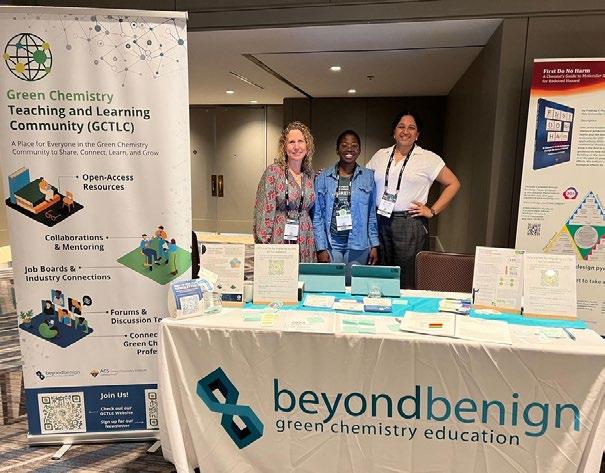
“Green chemistry … involves designing the molecular building blocks of products to be safe for humans and the environment.”
— Amy Cannon
Rethinking the way we are educating scientists and students is the first step, Cannon explained. The education system is the most powerful means to standardize green chemistry, and with the right support, educators can feel empowered to embrace sustainability and green chemistry as part of their work. At Beyond Benign, chemists

foster peer support networks and provide educators with expert resources to integrate green chemistry into their day-to-day teaching practices and research. By uniting these communities of practices, we can create communities of transformation, Cannon said.
“We’ve seen students be tremendous drivers of change in departments on campuses,” Cannon said.
Naturally, college students are leading green chemistry efforts on campuses. By working with faculty and department heads, students have taken initiative to integrate green chemistry into their research and curricula. At UW–Madison, students are innovatively approaching green chemistry and sustainability. The Office of Sustainability’s Green Labs Certification Program works with campus laboratories to better understand the impacts of research practices and create healthy and sustainable laboratory environments. As a student, it is important to never underestimate your power to demand change, Cannon emphasized.
When looking toward the future of green chemistry, Cannon reminds us to be hopeful:
“The field of green chemistry is progressive. We have to celebrate the small successes in order to get to the big sort of wins ... [it’s a] work in progress and a masterpiece at the same time.
In both music and research, undergraduate student Raines Lucas has a green future.
By Laila Smith
Raines Lucas is an undergraduate student at the University of Wisconsin–Madison, a guitarist in a touring band, and a GLUE researcher. No, not the glue that you’d use to mend a broken dish — the Global Land Use and Environment Lab, directed by Nelson Institute professor Holly Gibbs. Lucas, with a background in statistics, is working with other GLUE researchers to identify cropland expansion trends in the Midwest and beyond.
Lucas came to the UW to study mathematics and economics. “I’ve always really liked math. Specifically, I like mathematical modeling, or using statistics to model different scenarios, especially in human behavior,” says Lucas. But even though he knew what he liked to do, Lucas wasn’t quite sure how he would use those skills until after arriving on campus.

To Lucas, an environmental economics class and an introductory ecology class were both turning points in his academic career. “Those two classes helped me understand that the climate crisis isn’t just a carbon crisis, but also an ecological and ecosystem crisis,” he says. “It was eye-opening for me to understand what’s happening to our ecosystems, and the large-scale change they’ve seen in such a short amount of time.”
“I came to this university not really thinking about my role in an ecosystem — I saw them as things that we study, but not interact with,” says Lucas. “Since then, I’ve had a lot of wonderful professors that have helped me realize that I’m part of an ecosystem — we are all part of
an ecosystem, and every action we take affects these ecosystems even if we don’t realize it. Learning this was a legitimate epiphany of mine, and it completely changed my career trajectory,” he says.
When he graduates this spring, Lucas’s diploma will still list his majors as math and economics, but he now knows his true passions lie in agricultural and ecological economics — interests that led him to the Global Land Use and Environment Lab (GLUE) during his sophomore year. GLUE’s research focuses on examining how humans use land around the world, studying the environmental impact of those uses, and determining which steps can be taken to negate harmful outcomes.
Inspired by Holly Gibbs and Tyler Lark’s research in cropland expansion (converting grasslands into croplands),
Lucas joined the GLUE team as an undergraduate researcher to analyze trends in Midwest cropland expansion alongside Gibbs, Lark, and Christina Dennis, one of GLUE’s staff researchers. “My main research goal is to identify which properties are responsible for cropland expansion, what kinds of properties haven’t been expanding, and which properties are abandoning cropland,” says Lucas.
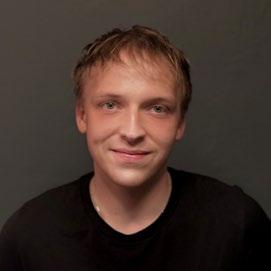
“What’s
band, she’s green. “I started playing guitar when I was in middle school, and it’s now become a focal point in my life,” he says. “I’m very fortunate to have gotten involved with this band and to have done awesome things with them.”
really cool about GLUE is that we try to understand large-scale transformations, which is hard to do because there are so many variables involved.”
— Raines Lucas
“It’s rare that one person is able to dictate land use changes over a massive area — it’s usually a large number of people with their own personal incentives,” says Lucas. “What’s really cool about GLUE is that we try to understand large-scale transformations, which is hard to do because there are so many variables involved.”
Working in the GLUE lab isn’t Lucas’s only research experience on campus; he is also part of the Climate Action Lab, run by Nelson Institute faculty affiliate Morgan Edwards. “I’ve gained so many skills from that lab that have allowed me to be more successful in GLUE,” says Lucas. “I love being part of both labs because even though they don’t have the same research topics, they’re both super fascinating and it’s been nice to gain totally different skills in each lab.”
Fortunately for Lucas, she’s green has many more “awesome things” in store for the future. Beginning in late February, the band started a two-month tour with more than 30 shows throughout the U.S. and Canada. “I love being with my band, and my current goal is to keep making music and touring,” Lucas says, “but at the same time, there’s no way I would give up research. It’s not just a job or resume builder for me.”

In addition to his research involvement, Lucas is also involved in Madison’s music scene. During his earlier undergraduate years, he was involved in the university’s student radio and helped book shows at Memorial Union and Union South through WUD Music. Now, he spends the majority of his free time playing guitar in his
“The research opportunities at UW–Madison have been wonderful, and everyone I’ve worked with and met through the Nelson Institute has been really amazing,” Lucas adds. “I know that I love research and I want to keep on doing research, and I feel really lucky to have that clarity.” Whether he’s strumming on stage or crunching numbers in a lab, one thing’s for sure: Lucas has a green future ahead of him.
Dorothy Lsoto hopes to advocate for and inspire other women through her PhD.
By Anica Graney
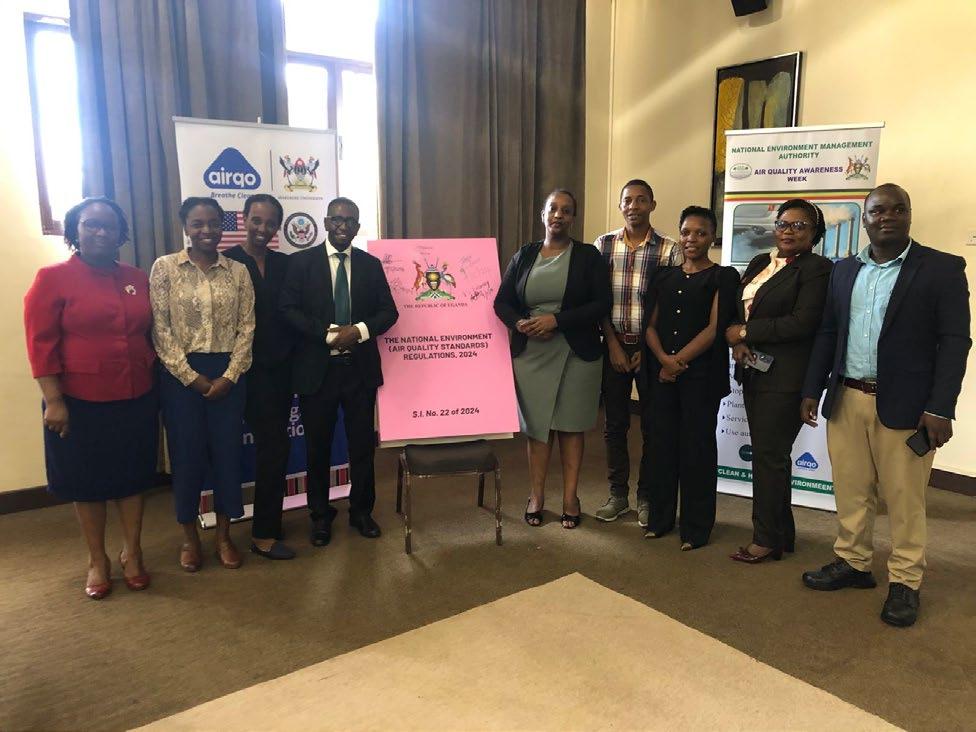

“Ultimately, I want to encourage other women, who may not see themselves represented in this field, to see themselves through me.”
— Dorothy Lsoto
Dorothy Lsoto never imagined she would be earning her doctorate in environment and resources at the Nelson Institute for Environmental Studies. Never mind the nearly 8,000 miles of land and sea between her hometown of Kampala, Uganda, and UW–Madison, Lsoto hadn’t even considered a career in the environment. Her heart was set on pursuing a law degree. But after getting accepted into a prestigious private law school with a hefty price tag, Lsoto made a selfless decision. She put her family first: changing her degree and attending a public university in Uganda for a much lower cost, saving her parents and seven siblings from the burden of her tuition.
“If I had decided to study the law, I knew that my sisters and brothers were not going to be able to go to school,” Lsoto explained. “I made up my mind at that point to tell my dad that I wasn’t interested in the law anymore. He was shocked because he knew that’s what I wanted to do.”
Lsoto began her undergraduate degree in environmental studies at Makerere University in Kampala, Uganda. It was hard work, not only keeping up with her science-based studies but also accepting her new path. “When I began the program, I was very sad because I knew I wasn’t going to achieve the dream that I wanted, and I had to convince all my friends and relatives that studying the environment was what I wanted to do,” Lsoto said.
In her last year of undergrad, Lsoto was introduced to renewable energies. A light bulb (most likely of the LED variety) went off in her head: she could help her community through clean technologies, like introducing clean cookstoves to households instead of using firewood to cook. “I want to fight for people who can’t fight for themselves,” Lsoto said. “This was my chance to help my, now late, grandma, and women like my grandma, in Uganda.”
Lsoto then joined the Makerere University Center for Research in Energy and Energy Conservation (CREEC) where she worked on a variety of research projects centered around renewable energy. She also joined entrepreneurial ventures to implement cookstove, pico-hydro, household solar, and biogas systems in Uganda. Through these projects, Lsoto met two Nelson PhD students, Sarah Stefanos and Aleia McCord, who then introduced her to Nelson faculty members Jonathan Patz and Rebecca Larson.
With their encouragement, Lsoto spent six weeks visiting UW–Madison, meeting professors, learning about the environment and resources program, and getting to know the area. “I am very grateful to Aleia and Becky because they played a very big role getting me to come to Madison and helped me pick my research topics,” Lsoto said, adding that McCord even helped her navigate the new educational landscape of graduate school in the United States.
“I want to fight for people who can’t fight for themselves.” — Dorothy Lsoto
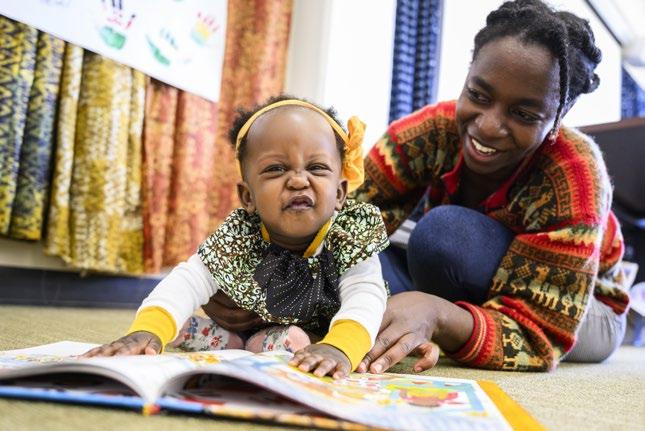


“It was powerful to be there and represent the Nelson Institute. I feel proud of those moments because I’m not just contributing to myself, but to the institute and the people that I work with.”
— Dorothy Lsoto
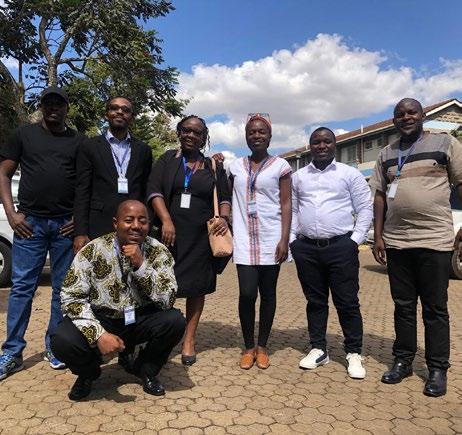
“Aleia has been my biggest advocate academically, professionally, and personally. She’s my biggest cheerleader.”
In addition to her newfound support system, Lsoto found her master’s necessary to be taken seriously in her field. “Most of the energy-related projects worked with women but often excluded them from decision-making besides their voices being absent from 30 years of failed cookstove interventions,” Lsoto explained. “Sometimes I would recommend things because I know what these women and communities wanted, but then it was different from what the international funders wanted.”
Seeing how projects were funded and implemented got Lsoto to think: what if she designed her own projects? This question, along with a new interest in exploring policy and air quality, drove Lsoto to continue her studies and develop a PhD at the Nelson Institute which she is currently pursuing. Patz, whose research interests match her own, serves as her advisor. “I enjoyed his class so much because we talked about climate change and things that were affecting the people where I come from,” Lsoto said. “I made a connection between his class and my reality.”
As a graduate student, Lsoto teaches a capstone class that focuses on air quality and equity in African cities. Through this class, Lsoto connected with policymakers in the National Environment Management Authority of Uganda, equivalent to the Environmental Protection Agency in the United States, and was asked to take part in writing Uganda’s first National Environment Air Quality Standards Regulations and the Kampala Clean Air Action Plan with the Kampala Capital City Authority (KCCA). “It was powerful to be there and represent the Nelson Institute. I feel proud of those moments because I’m not just contributing to myself, but to the institute and the people that I work with,” Lsoto said.
Adding to her accomplishments, Lsoto was awarded the University Corporation for Atmospheric Research (UCAR) Next Generation Fellowship in September 2024, which will support her as she continues her PhD research. She is also a 2025 Edward Alexander Bouchet Graduate Honor Society Scholars and has been selected to join the Phi Beta Kappa Society. “When I am researching, I don’t see it as just me working on my PhD. I know that my niece, who has not seen anyone in my family with a PhD, will see me with one, and maybe she’ll choose to do that, too,” Lsoto said. “Ultimately, I want to encourage other women, who may not see themselves represented in this field, to see themselves through me.”
Day of the Badger, a celebration of what makes UW–Madison great, is coming back April 8–9!
Save the date to join the philanthropic festivities and help to make Nelson stronger today for the Badgers of tomorrow. Watch your email and follow along on our social media accounts (@nelsoninstitute).

APRIL 8–9

April 14–15, 2–6 p.m. each day Memorial Union
Join the Nelson Institute’s Center for Ecology and the Environment as they host their annual spring symposium. This two-day event highlights the variety of ecology research across campus, with a focus on early career ecologists including undergraduates, graduates, and postdoctoral researchers. This year features keynote speaker Matthew Betts from the Oregon State University. Register today!
Interested in supporting the Nelson Institute?
There are many ways to contribute to the Nelson Institute — participating in our events, mentoring our students, providing connections to your personal networks, and making financial gifts. All of these are necessary and important to us, and we invite you to invest in our community in the way that makes the most sense to you.
Learn more about all of the great academic programs, research centers, and public programs we offer.

By Esther Seidlitz, Wisconsin Foundation and Alumni Association

Ice scrapers, shovels, snowblowers, sand, and salt. Wisconsinites have a whole arsenal of weapons to fight slippery conditions. Allison Madison MS’11 is here to remind winter warriors to reach for the salt last — and to use just a pinch when the time comes.
According to Madison, program manager for Wisconsin Salt Wise, just a teaspoon of salt is enough to pollute five gallons of water. “Salt reduces rates of growth, reduces rates of reproduction, and makes freshwater organisms more susceptible to parasites. Think of it like a stressor,” Madison says. “If you or I put tons of salt on our food every meal, eventually, it’s a stressor on our system. Each winter, we apply one to two million tons of salt to roads, parking lots, and sidewalks across Wisconsin. All that salt ends up in our water.”
Oversalting also contributes to other Wisconsin woes: rusty vehicles, frequent road construction and repair work, less productive soil, and algae blooms in our lakes. At Wisconsin Salt Wise, Madison works with the Wisconsin Department of Transportation, the Wisconsin Department of Natural

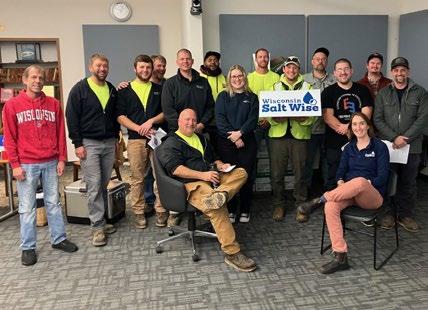
Resources, and a broad network of municipalities, watershed advocacy groups, and snow removal companies to limit the environmental and economic stress caused by salt, while still ensuring safe roads and sidewalks. Below, she shares a few tips on how you can help.
“Each winter, we apply one to two million tons of salt to roads, parking lots, and sidewalks across Wisconsin. All that salt ends up in our water.”
– Allison Madison
Shoveling Comes First “The number one [thing you can do] is getting out there to shovel or snow blow. Get out early and often so you can prevent that hardpack from forming and turning

into ice.” And if there’s just a dusting of snow, a broom will do the trick.
If a layer of ice does form, break out the scraper. “There’s one called the Ultimate Scraper, and it looks just like a big metal spatula. It can get under the hardpack and chip away at it.”
The right conditions may be able to save you some elbow grease. “If it’s going to be warming, maybe you shovel the majority of the snow and the sun or warming temps take care of the rest.”
Sand is Your Friend — and the Environment’s, Too Sand improves traction, and it’s cheaper and easier to get than alternatives like seed, ash, or kitty litter. “Anything that we put down is going to make its way into our water. If you use sand, try to sweep it afterwards or sweep it into your lawn so it doesn’t end up first in a storm drain and eventually your local lake or stream.”
When it does come time to break out the salt, you probably don’t need as much as you might think. When scattered evenly, a coffee mug of salt is typically enough to de-ice a 20-foot driveway or 10 sidewalk squares. Pavement temperature is also a factor — if the temperature of the surface in question is below 15 degrees, salt won’t do the job. This guide can help determine which deicing solution works best for particular conditions.
This story was originally published by the Wisconsin Alumni Association.








